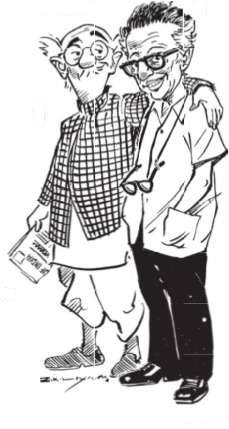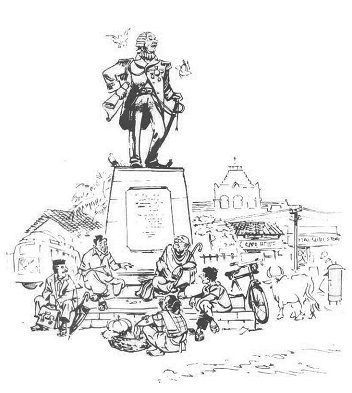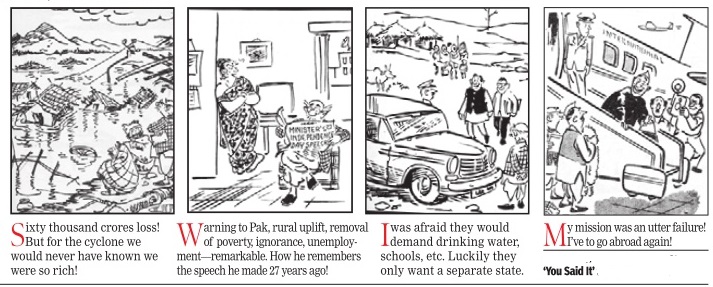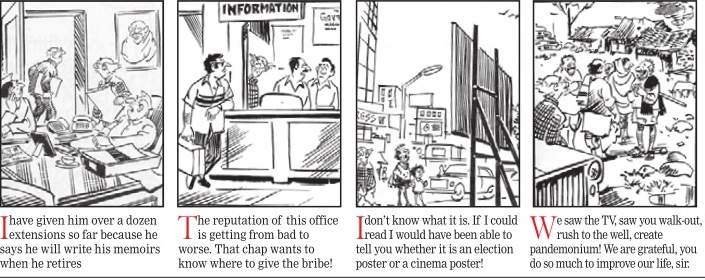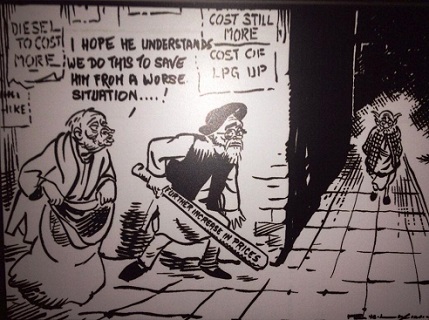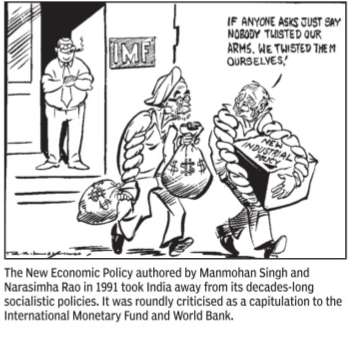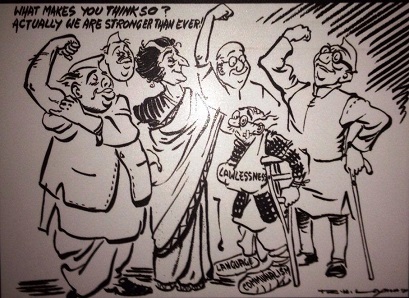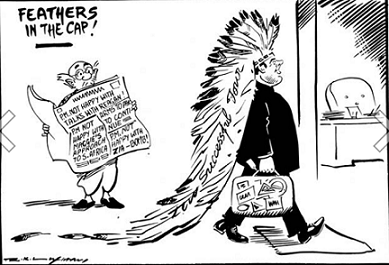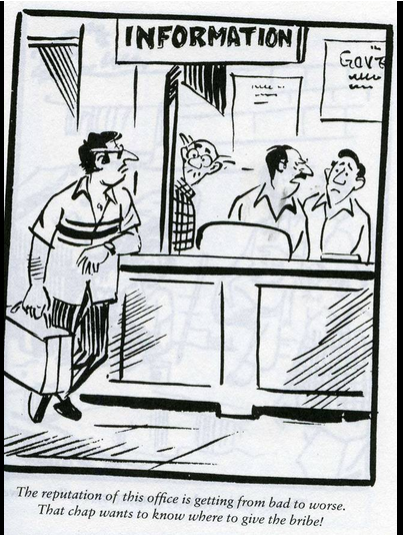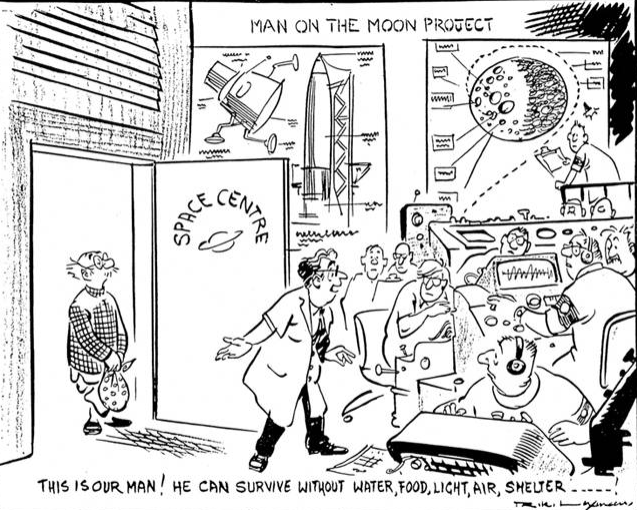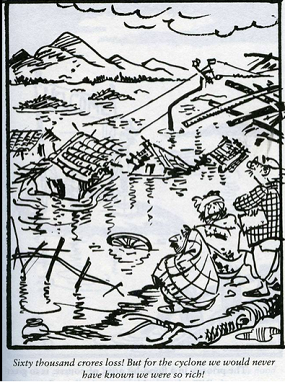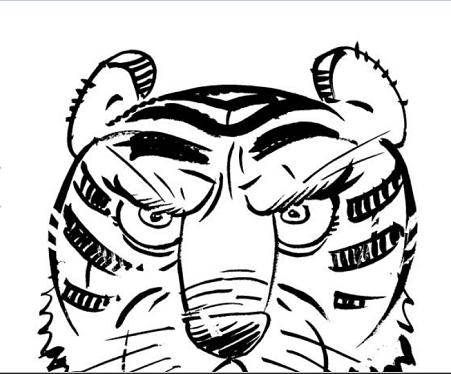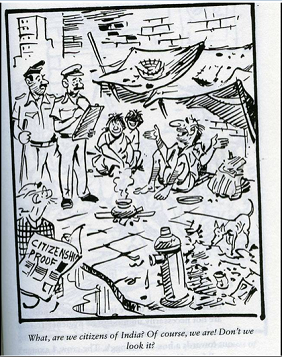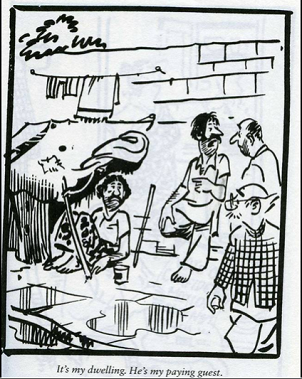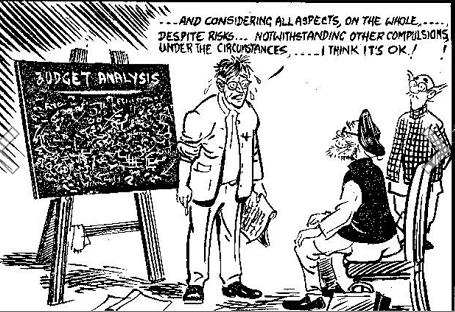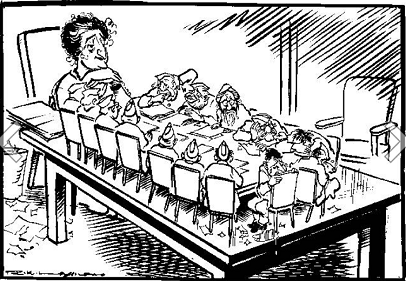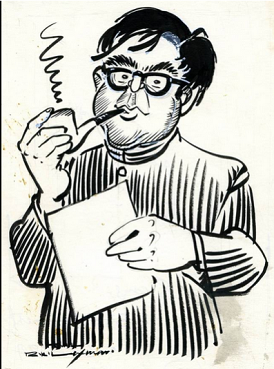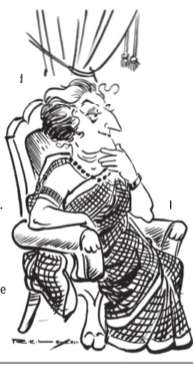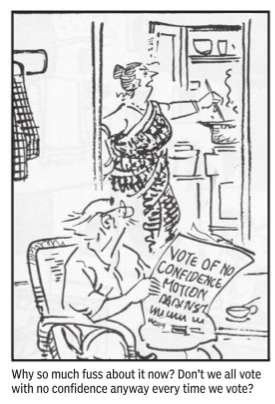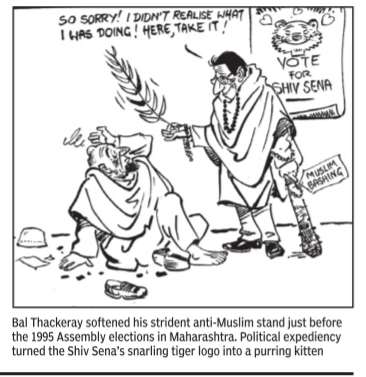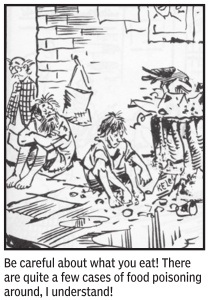R.K. Laxman
This is a collection of articles archived for the excellence of their content. |
The sources of the cartoons include...
Best of RK Laxman's cartoons The Times of India
The man
R K Laxman, nation's uncrowned conscience keeper
Laxman, the youngest of six siblings, was born Oct 24, 1921, in Mysore. He showed promise very early in life. The illustrations in The Strand, Punch, Bystander and Tit-Bits, reputed British magazines, spurred his innate talent which found an outlet in his own house. He drew on its floor, walls and doors, sketched caricatures of his school teachers. Sir David Low, the world-famous cartoonist whose sketches also appeared in the Hindu, also influenced him.
R K Laxman, considered by many as one of the world's greatest cartoonists, was an institution unto himself, indisputably the uncrowned conscience keeper of the nation. No politician or minister, however high or mighty, escaped his pointed satire, conveyed through a few deft strokes of his brush, especially if they committed an act of impropriety or indiscretion.
Laxman's 'common man', who graced the front pages of The Times of India for more than five decades, under "You Said It" acquired an iconic stature of its own. These pocket cartoons not only conveyed the pulse of a nation, but also unfailingly delivered powerful messages. At the same time they mirrored the hopes and aspirations, follies and foibles of a society in transition.
The cartoons of Laxman became the defining moments in nation's history, as for instance, the one on Aryabhatta, India's first satellite. A couple of middle-aged office-goers are waiting at a bus stop. One of them wants to know the time. As soon as the other looks at his watch and answers, the questioner looks skywards, exclaims: "Aryabhatta must have completed one orbit by now."
His huge canvas spanned local, national and global personalities and issues, born out of his deep understanding of the cross currents shaping the world. His take on Angolan crisis in which both the super powers fought through proxies, at the height of the Cold War, shall remain among his many unforgettable cartoons.
The three-column illustration depicts Leonid Brezhnev and Jimmy Carter, presidents of erstwhile USSR and US, who are stealthily stepping across the coast of Angola, both armed and in the guise of burglars. Carter cries "thief-thief" as soon as he spots his burly opposite number. It exposes their double-speak and evokes laughter at the irony. These cartoons speak volumes about Laxman's capacity to convey complex geopolitical realities in his characteristic style.
Laxman's cartoons, undoubtedly the outcome of a brilliant mind, also entailed sheer hard work. It meant isolating himself for six hour daily, neither speaking nor listening to anyone during the period. "Searching for new ideas is an endless process. You have to come up with new and innovative idea each day," he said.
Some of the tomes showcasing Laxman's perspective also include the one which appeared just after the 1971 India-Pakistan war, in three columns, in his inimitable style. General Yayha Khan, pointing to the stack of destroyed Pakistani tanks and planes in the background, tells Zulfikar Ali Bhutto, with a smile: "Have I not made it seem like a thousand-year war," (which only lasted 14 days). Bhutto often boasted about waging a millennial war against India.
His work
Laxman immortalized passive, hapless common man
PTI | Jan 26, 2015 The Times of India
Capturing the entire gamut of idiosyncrasies of Indian politicians in an innocuous newspaper box with his cartoons, R K Laxman immortalized the passive, hapless common man with an uncanny perception and sarcasm in a daily commentary on his life that brought smiles to millions.
Every morning for over five decades, his fans waited for the 'common man' who, with his signature checked jacket, dhoti, Gandhi-glasses and twin tufts of gravity-defying hair, watched life and politics in India.
With his masterful strokes using the space of couple of inches, he exposed the hypocrisy in politics, leaving many a politician red-faced.
The son of a school teacher, Rasipuram Krishnaswamy Laxman, who rose to become India's best known political cartoonist, was born in Mysore on October 24, 1921. He was one of the seven siblings that included his elder brother eminent novelist R K Narayan.
With a penchant for drawing since his school days, Laxman was engrossed by the illustrations in magazines such as "Punch", " Tit-Bits", " Strand" and " Bystander" and came under an early influence of world renowned British cartoonist Sir David Low.
A creative genius, Laxman was known to have started doodling even before he could read, using floors, walls and doors of his house.
His artistic bent of mind was appreciated by a school teacher who noticed a drawing by him on a peepal leaf.
In his autobiography "The Tunnel of Time", the legendary cartoonist recalls, "I drew objects that caught my eye outside the widow of my room--- the dry twigs, leaves and lizard like creatures crawling about, the servant chopping firewood and of course, the number of crows in various postures on the rooftops of the buildings opposite?".
The crow was also a common figure in his cartoons later on.
Overcoming the setback in the death of his father, the young Laxman completed high school education and sought admission to Mumbai's J J School of Arts.
Ironically his application was rejected by the dean who remarked that his drawings "lacked the kind of talent required to qualify for enrolment in our institution as a student".
Laxman subsequently graduated with a Bachelor of Arts from University of Mysore even as he continued with freelancing and contributed cartoons to " Blitz", " Swarajya" and an animated film based on the mythological character of "Narada".
While at the Maharaja's College of Mysore, Laxman started illustrating R K Narayan's short stories in 'The Hindu' and also drawing political cartoons for local newspapers and a Kannada magazine devoted to humour titled " Koravanji", founded in 1942 by Dr M.Shivaram who encouraged the budding cartoonist. When he took up his first full time job as a political cartoonist at Mumbai's Free Press Journal, Laxman incidentally found himself in the company of Bal Thackeray who too worked in the same paper as a cartoonist for a brief period.
But his legendary spell on the Indian newspaper reader was cast after joining the Times Of India (TOI).
The comic strip "You said it" started in 1951, unleashing his iconic "common man", a silent witness to the shenanigans of politicians who were supposed to realise his dreams, hopes and aspirations but betrayed him on most occasions.
His association with TOI continued through the six decades even as he got back to work after recovering from a paralytic stroke in 2003 that incapacitated his left side.
A versatile artist, Laxman also wrote novels - Hotel Riviera and the Messenger, published by Penguin and contributed distinctive illustrations to many works including the "Malgudi Days" stories penned by his brother R K Narayan.
His autobiography in English "The Tunnel of Time' is translated into Marathi under title "Laxmanrekha". In a fitting tribute to the "Common Man" who attained a cult status, a commemorative postal stamp was issued featuring it in 1988 on the occasion of the 150th anniversary of TOI.
Among the honours bestowed on the cartoonist are B D Goenka award-Indian Express, Durga Ratan Gold medal - Hindustan Times, Padma Bhushan, Padma Vibhushan and the Magsaysay award in 1984 for Journalism, Literature and creative communication arts.
Laxman, married to author Kamala, later settled down at his Pune residence from where he continued his work. A 16 ft. bronze statue of the 'Common Man", sculpted by Vivek Khatavkar, was unveiled in the premises of the Symbiosis Institute here on December 19, 2001 in the presence of its creator.
Excerpts from Laxman’s autobiography
HONOURED BY INDIRA, BANNED BY MORARJI
The Times of India Jan 27 2015
A PADMA BHUSHAN FROM THE LADY I KEPT MAKING FUN OF!
A man who introduced himself as an official from the home ministry, New Delhi, said he had brought the good news that the PM had approved of the list of Padma Bhushan awardees and my name was included in it. I was stunned; here I was attacking and making fun of her in my cartoons, and she had seen fit to confer this honour on me! I suspected a catch in this somewhere!...I asked for a little more time to decide... Finally I agreed to accept the honour. The official announcement was made and congratulatory messages poured in from all parts of the country.
A circular from the home minister followed from Delhi, asking me to be present in the capital for rehearsals... If I was to bring my spouse I had to bear the expenses of her travel, and on the day of the function she should dress soberly, wearing a sari whose border should not be more than two inches broad! Fortunately I was spared the ordeal of attending the rehearsal as well as the ceremony as I had accepted an invitation to Germany at that time.Ten months later, the citation declaring that I was a Padma Bhushan and two medals--one big and another small--were delivered by a postman to my flat. There was a note from the home secretary stating that the big medal was to be worn for formal occasions and the small one on informal occasions. However, it hinted that neither should be displayed conspicuously.I am still to understand what these instructions meant.
T S ELIOT SNOOZED AS I SKETCHED HIM
A couple of days later I was sitting with T S Eliot in his study. He uttered some obvious pleasantries but was mostly silent. As I began to make rough sketches of his tall figure, large nose and dreamy eyes, I told him about a poet I had met in London, who claimed that he knew Eliot so well that Eliot had written an introduction to a collection of that man's poems, currently in the press. When I mentioned the individual's name, Eliot raised his eyebrows and said he had neither heard of the poet nor had he written a foreword to any such book! Then he sat still, as if posing for an oil portrait. I made an elaborate pencil study of him. When I finished I held it out for him to autograph. He continued to sit without stirring. I had to clear my throat loudly, for he had gone to sleep. He woke up with a start and looked apologetic. He gazed at my drawing with amusement and signed it cheerfully.
THE COMMON MAN WAS A SILENT SPECTATOR
For a long time I believed I was providing the readers with some comic relief in their dreary humdrum existence. The bespectacled Common Man in his checked coat had walked into my cartoon spontaneously, as if I had no hand in his creation. Equally effortlessly he became a silent spectator of events, moving with ease from drought-stricken villages to the airport to watch foreign delegations arriving... Once he even visited the South Pole along with a minister for commerce who held bilateral talks with a group of attentive penguins.In the course of time I was surprised to discover that my readers looked upon me not merely as a cartoonist who tickled their sense of humour, but as a profound thinker, a social reformer, a political scientist, a critic of errant politicians and so on. I received letters complaining about postal delays, telephones, the sloppiness of municipal authorities, inflated electric bills, bribes in school admissions. One such letter pleaded, `Please halt the 47 Down train at ...... for a few minutes to save me the bother of waiting for four hours for the next one to go home from the office'.
WHEN GAMBLERS SAW HIDDEN SIGNS IN MY WORK
A nother offbeat incident revealed that my cartoons, besides provoking laughter, had a mystic appeal to a section of the public. In those days, betting on numbers was quite a popular pastime, though illegal. Gamblers somehow saw the possible lucky combinations of numbers in my cartoons. It went roughly along these lines --suppose there were four people in the cartoon on a particular day, with three looking one way and one the other way, that somehow provided sufficient clues for the gamblers to speculate accordingly... The number of lamp-posts, cars in a street scene, people in a bus queue were all indicators to where the treasure lay.
One morning, a fat fellow who looked like a trader, clad in an immaculate white kurta and dhoti with a gold chain adorning his neck, was waiting for my arrival at the office. He took out a sheaf of high denomination currency notes and offered it to me, asking in return for the favour of just one glimpse of the following morning's cartoon. This would help him to read the mysterious number hidden in it and thus gamble ahead of his rivals and make his fortune. It was not difficult to get rid of this customer. All I had to do was bring up imaginary legal objections to such a transaction, as specified in my contract as an employee of The Times of India. Before I could continue my narration to point out the illegality of betting, the chap had left the room and scooted away.
WHAT ON EARTH DOES THIS CARTOON MEAN?
Wading through the sea of dog-eared sketches, I had to face another problem.Some of the cartoons made no sense at all.
N What in Heaven's name could they be referring s to? Perhaps they had brought national applause I on the day they were flashed on the front page of The Times of India. Perhaps the political clown shown in one cartoon was the chief minister of a minor state or a junior in the central cabinet, whose indiscretions and irresponsible pronouncements might have invited the attention of the whole nation, including mine, inspiring me to do the cartoon.The character must have since disappeared from the political scene; no trace of him existed now except the frayed drawing I was puzzling over! I was also nagged by the proliferation of acronyms. I had inscribed Congress (SDK), LB, KPSS, ABWU, OPPUWF and so on across the shirts of their leaders, on tattered flags, on tigers, pythons, bulls... It is in the nature of political cartoons to have a very short life except those few that satirize momentous national events.
MORARJI DESAI CALLED A CABINET MEETING TO BAN ME
I congratulated myself on having acheived a harmonious routine--work, a couple of drinks in the evening at home in the company of my family and retiring early to read in bed. All this was shattered when Morarji Desai became the chief minister of Maharashtra and introduced prohibition to snuff out what he perceived as the evil habit of drinking. It was said he would not even drink plain water to quench his thirst, but would prepare his own 'recycled liquid' from within himself and consume that!Morarji Desai also banned horse racing and crossword puzzles.A cartoon I drew on this theme annoyed him so much that he held a full cabinet meeting to muzzle me and ban making the government, politicians and ministers objects of ridicule in the name of humour. He was told there was no way of stopping the cartoons since our Constitution fully protected the freedom of expression.
RAJIV BEGAN TO RESEMBLE MY CARTOONS OF HIM
I knew Rajiv Gandhi would prove to be a difficult subject. He was tall, young and handsome.There was nothing in his physical features I could capture, exaggerate and exploit for my benefit. Besides... he had ideas that were lofty, progressive and of scientific temper. I was worried that if he succeeded, I would lose my job.
But soon my hopes revived... The Congress-I candidates for the Lok Sabha elections were found to be star actors, dancers, celebrity sportsmen and so on. I was able to gather plenty of ideas from Rajiv Gandhi's style of functioning. I even managed to find points in his features for distortion. I made him look a little more rotund than he really was, I shortened his nose and tilted it slightly upward. I thickened his eyebrows and reduced the hair on his pate, making him nearly bald. Thus, having remodelled him to suit my purpose, I began to produce this image day after day for the Times. Shortly, people started to remark that Rajiv had begun to resemble my cartoon version of him, losing his original God-given good looks!
`DID YOU DRAW THIS YOURSELF, LAXMAN?'
He asked us to queue up and began to critically examine our efforts one by one, murmuring comments and giving marks.Sometimes he twisted a boy's ear or brought the cane down on the leg of another. When it was my turn he stared at the drawing for an alarmingly long time and asked me, “Did you draw it yourself, Laxman?“ I was frightened and stepped back, expecting a shower of blows. I replied, “You asked us to draw, Sir... I sat there and drew...“ fumbling for a safe excuse. But to my great surprise and joy, he held my slate up before the class and announced, “Attention! Look how nicely Laxman has drawn the leaf.“ He turned to me and said, “You will be an artist one day. Keep it up.“...I was inspired by this unexpected encouragement. I began to think of myself as an artist in the making, never doubting that this was my destiny.
POLITICIANS LIKE CARTOONS WHEN...
As a rule I avoided meeting politicians. In my professional life I had learnt that when a politician congratulated me on my cartoon of the day and thumped me on the back saying I was a genius, he had just seen a nasty cartoon about his political enemy in the opposition or in his own party. On the other hand if a politician pumped my hand with warm and generous admiration for a cartoon in which I had ridiculed him, he was bound to start quietly telling me in a roundabout way that I lacked political judgement, and end up teaching me how to draw cartoons.
(Excerpted by The Times of India from 'The Tunnel Of Time' by R K Laxman, with permission from Penguin Books India)
